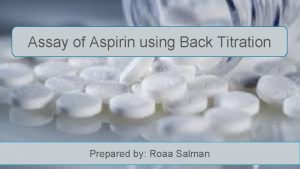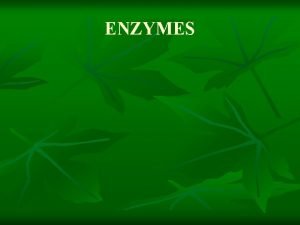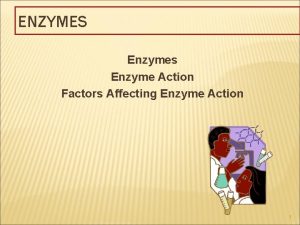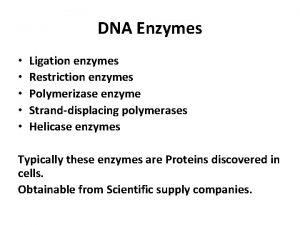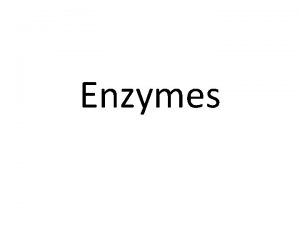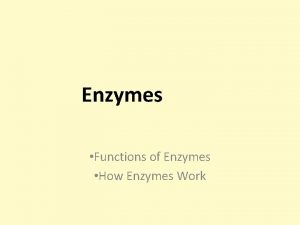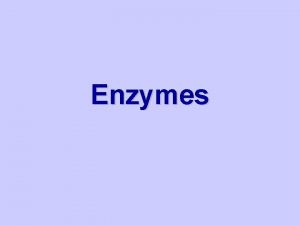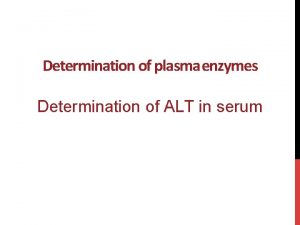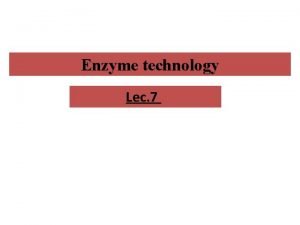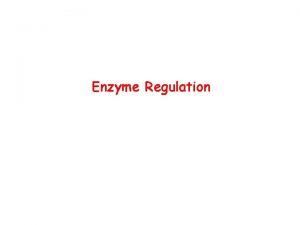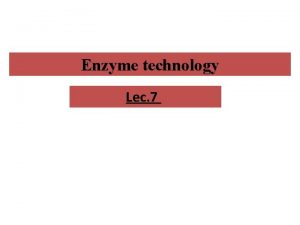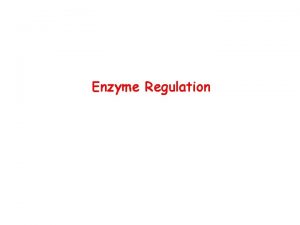PLASMA ENZYME Determination of plasma enzymes using the
















- Slides: 16

PLASMA ENZYME Determination of plasma enzymes using the clinical analyzer

Blood plasma contains many enzymes which are classified into: 1. Functional plasma enzymes 2. Non functional plasma enzyme

Source Non functional plasma enzyme Cell damage with the release of its content of enzymes into blood e. g. Myocardial infarction and viral hepatitis Obstruction of normal pathways e. g. Obstruction of bile duct increases alkaline phosphatase Increase of the enzyme synthesis e. g. bilirubin increases the rate of synthesis of alkaline phosphatase in obstructive liver disease Increased permeability of cell membrane as in hypoxia

non functional enzymes in medical Measurement of non functional enzymes is important for: Diagnosis of diseases Prognosis of the disease

Lactate Dehydrogenase (LDH) * Lactic acid dehydrogenase (LDH) is an enzyme that helps produce energy * Normal LDH levels range from 45 U/L to 90 U/L. * LDH is most often measured to evaluate the presence of tissue damage. (diagnostic ) * The enzyme LDH is in many body tissues, especially the heart, liver, kidney, skeletal muscle, brain, blood cells, and lungs. .

LDH reaction Lactate is released into the blood and is eventually taken up by the liver. The liver converts lactate back to glucose and releases glucose into the blood. This glucose is then taken up by resting muscles, red blood cells, and other Tissue

*Exercising muscles convert (and red blood cells metabolize) glucose to lactate. *The optimum p. H for lactate pyruvate (L� P) reaction is 8. 8 – 9. 8 *while for pyruvate to lactate (P� L) is 7. 7 – 7. 8. 8 * The enzyme is inhibited by sulfhydryl reagents such as P-chloromercuribenzoate and mercuric ions.

LDH isoenzyms LDH exists in 5 forms (isoenzymes), which differ slightly in structure. LDH Isoenzyme Tissues Enzyme Level U/G LDH-1 is found primarily in heart muscle and red blood cells. 160, 000 LDH-2 is concentrated in WBC 16, 000 – 62, 000 LDH-3 is highest in the lung LDH-4 is highest in the kidney, placenta, and pancreas 250, 000 -300, 000 LDH-5 is highest in the liver 260, 000 and in skeletal muscle 133, 000

Disease LDH Level Myocardial infarction LDH level 6 -10 times normal Liver Disease Toxic jaundice LDL level 10 times Viral hepatitis LDH level is lower than 10 times Obstructive jaundice Anemia Pernicious anemia Megaloblastic anemia Renal Diseases Tubular necrosi LDH Pyelonephritis Malignant Disease Hodgkin‟s disease LDL level 2 times LDH level 50 times LDH level 20 times LDH Lung Cancer LDH

All of these isoenzymes can be measured in the blood, and can be separated by electrophoresis.

OBJECTIVE Determination of LDH (Lactate Dehydrogenase) in Serum

Principle LDH is a hydrogen transfer enzyme which catalyzes the interconversion of pyruvate and lactate. In the liver, it catalyzes the oxidation of L-lactate to pyruvate (L� P) with the mediation of NAD as hydrogen acceptor. The reaction is reversible and the reaction equilibrium strongly favors the reverse reaction, namely the reduction of pyruvate to lactate (P� L). The formation of NADH produces an increase in absorbance at 340 nm. The rate of absorbance change is directly proportional to the activity of LDH in the specimen.

Reagents LDH Reagent [Lactate solution (51. 6 mmol/l) + NAD (8. 26 mmol/l) in tris buffer)

Procedure � � � In Test Tube Pipette 3 ml of the LDH reagent Pre-warm the tube at 37 C for 3 min Pipette 0. 1 ml (100µl) of serum sample Mix, and allow 1 min for temperature equilibration Read the absorbance at 340 nm every minute for 3 min against H 2 O

Procedure Absorbance A 1 A 2 A 3 ∆A/min

Calculations Then calculate A 1, = A 2 - A 1 A/min = ( A 1+ A 2) / 2 A 2 = A 3 – A 2 Calculations LDH (U/L) = A x 4921
 Enzymes of blood plasma
Enzymes of blood plasma Non functional plasma enzyme
Non functional plasma enzyme Non functional plasma enzymes
Non functional plasma enzymes Aspirin back titration
Aspirin back titration Lời thề hippocrates
Lời thề hippocrates Chụp phim tư thế worms-breton
Chụp phim tư thế worms-breton đại từ thay thế
đại từ thay thế Vẽ hình chiếu đứng bằng cạnh của vật thể
Vẽ hình chiếu đứng bằng cạnh của vật thể Quá trình desamine hóa có thể tạo ra
Quá trình desamine hóa có thể tạo ra Thế nào là mạng điện lắp đặt kiểu nổi
Thế nào là mạng điện lắp đặt kiểu nổi Khi nào hổ con có thể sống độc lập
Khi nào hổ con có thể sống độc lập Các châu lục và đại dương trên thế giới
Các châu lục và đại dương trên thế giới Các loại đột biến cấu trúc nhiễm sắc thể
Các loại đột biến cấu trúc nhiễm sắc thể Biện pháp chống mỏi cơ
Biện pháp chống mỏi cơ Bổ thể
Bổ thể Phản ứng thế ankan
Phản ứng thế ankan Thiếu nhi thế giới liên hoan
Thiếu nhi thế giới liên hoan



